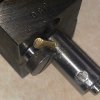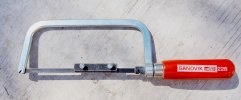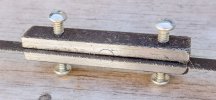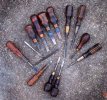First step is to center the cavity then spot drill. This is a photo of the spot made with my phone. No way was I taking the mould out of the vise and then recentering it.
Follow that with a drill and ream to .1645.

Then I made the pin from a piece of .164 drill rod. Nice and round.
Pin goes into a .375 collar which is also reamed .1645. It was held with some blue Loctite, let sit for 15 min, then drill and seat a cross pin to keep them aligned. This gives a good surface to butt against the bottom of the mould, a place to drill and tap for the pin the keeps it in place when casting, and a surface for gluing into the handle.
I used to make all of this, and a collar for holding in place when casting, but this is way faster and easier.
Drill and tap for screw in bottom of mould and make the screw. Takes a little thinking to get the head far enough away from collar to not interfere. I also make a shoulder under the head of the screw to locate it firmly on bottom of the mould. Making the screw is pretty easy using a die holder on the lathe.
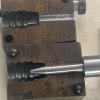
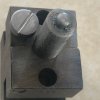
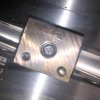
I now need to drill and tap for the cross pin that keeps the HP pin in place when casting and file it to fit. That is all pretty quick and easy work.
All told it takes a solid hour if I don’t get interrupted. I love this kind of stuff.
Follow that with a drill and ream to .1645.

Then I made the pin from a piece of .164 drill rod. Nice and round.
Pin goes into a .375 collar which is also reamed .1645. It was held with some blue Loctite, let sit for 15 min, then drill and seat a cross pin to keep them aligned. This gives a good surface to butt against the bottom of the mould, a place to drill and tap for the pin the keeps it in place when casting, and a surface for gluing into the handle.
I used to make all of this, and a collar for holding in place when casting, but this is way faster and easier.
Drill and tap for screw in bottom of mould and make the screw. Takes a little thinking to get the head far enough away from collar to not interfere. I also make a shoulder under the head of the screw to locate it firmly on bottom of the mould. Making the screw is pretty easy using a die holder on the lathe.



I now need to drill and tap for the cross pin that keeps the HP pin in place when casting and file it to fit. That is all pretty quick and easy work.
All told it takes a solid hour if I don’t get interrupted. I love this kind of stuff.
Last edited:



